Merging Galaxies And Droplets Of Starbirth

Merging galaxies and droplets of starbirth
The Universe is filled with objects springing to life, evolving and dying explosive deaths. This new image from the NASA/ESA Hubble Space Telescope captures a snapshot of some of this cosmic movement. Embedded within the egg-shaped blue ring at the centre of the frame are two galaxies. These galaxies have been found to be merging into one and a “chain” of young stellar superclusters are seen winding around the galaxies’ nuclei.
At the centre of this image lie two elliptical galaxies, part of a galaxy cluster known as [HGO2008]SDSS J1531+3414, which have strayed into each other’s paths. While this region has been observed before, this new Hubble picture shows clearly for the first time that the pair are two separate objects. However, they will not be able to hold on to their separate identities much longer, as they are in the process of merging into one.
Finding two elliptical galaxies merging is rare, but it is even rarer to find a merger between ellipticals rich enough in gas to induce star formation. Galaxies in clusters are generally thought to have been deprived of their gaseous contents; a process that Hubble has recently seen in action. Yet, in this image, not only have two elliptical galaxies been caught merging but their newborn stellar population is also a rare breed.
The stellar infants — thought to be a result of the merger — are part of what is known as “beads on a string” star formation. This type of formation appears as a knotted rope of gaseous filaments with bright patches of new stars and the process stems from the same fundamental physics which causes rain to fall in droplets, rather than as a continuous column.
Nineteen compact clumps of young stars make up the length of this “string”, woven together with narrow filaments of hydrogen gas. The star formation spans 100,000 light years, which is about the size of our galaxy, the Milky Way. The strand is dwarfed, however, by the ancient, giant merging galaxies that it inhabits. They are about 330,000 light years across, nearly three times larger than our own galaxy. This is typical for galaxies at the centre of massive clusters, as they tend to be the largest galaxies in the Universe.
The electric blue arcs making up the spectacular egg-like shape framing these objects are a result of the galaxy cluster’s immense gravity. The gravity warps the space around it and creates bizarre patterns using light from more distant galaxies.
Image credit: NASA, ESA/Hubble and Grant Tremblay (European Southern Observatory)
More Posts from Evisno and Others









We’re Way Below Average! Astronomers Say Milky Way Resides In A Great Cosmic Void
“If there weren’t a large cosmic void that our Milky Way resided in, this tension between different ways of measuring the Hubble expansion rate would pose a big problem. Either there would be a systematic error affecting one of the methods of measuring it, or the Universe’s dark energy properties could be changing with time. But right now, all signs are pointing to a simple cosmic explanation that would resolve it all: we’re simply a bit below average when it comes to density.”
When you think of the Universe on the largest scales, you likely think of galaxies grouped and clustered together in huge, massive collections, separated by enormous cosmic voids. But there’s another kind of cluster-and-void out there: a very large volume of space that has its own galaxies, clusters and voids, but is simply higher or lower in density than average. If our galaxy resided near the center of one such region, we’d measure the expansion rate of the Universe to be higher-or-lower than average when we used nearby techniques. But if we measured the global expansion rate, such as via baryon acoustic oscillations or the fluctuations in the cosmic microwave background, we’d actually arrive at the true, average rate.
We’ve been seeing an important discrepancy for years, and yet the cause might simply be that the Milky Way lives in a large cosmic void. The data supports it, too! Get the story today.

New Discoveries about Star Formation in the Flame Nebula
Stars are often born in clusters, in giant clouds of gas and dust. Astronomers have studied two star clusters using NASA’s Chandra X-ray Observatory and infrared telescopes and the results show that the simplest ideas for the birth of these clusters cannot work.
This composite image shows one of the clusters, NGC 2024, which is found in the center of the so-called Flame Nebula about 1,400 light years from Earth. In this image, X-rays from Chandra are seen as purple, while infrared data from NASA’s Spitzer Space Telescope are colored red, green, and blue.
A study of NGC 2024 and the Orion Nebula Cluster, another region where many stars are forming, suggest that the stars on the outskirts of these clusters are older than those in the central regions. This is different from what the simplest idea of star formation predicts, where stars are born first in the center of a collapsing cloud of gas and dust when the density is large enough.
Credit: NASA/Spitzer/Chandra
A little more help for focusing-on beginers: In terms of cognitive demand, it is more difficult to focusing on your ongoing task when you have a long to-do list than when only a few more tasks left. So I recommend you to try making schedule with less than 5 tasks a day. It will be much easier to organize work of different fields or of different shades of cognitive demand.
How focusing (aka. not multi-tasking) changed my study life
I had heard it occasionally - that multi-tasking was actually not good for the quality of whatever task I was doing. It made sense, but I loved mult-tasking so much. It gave me the illusion of productivity.
Until I actually tried focusing for a while, did I realise how much I was actually losing by multi-tasking - educationally and emotionally. Scrolling through tumblr during boring parts of a lecture seemed fine, since there were notes and it probably wouldn’t be tested in such depth anyway. Eating, while scrolling through social media, while watching a tv show, while messaging someone on facebook seemed ‘productive’.
It turns out it was the opposite. It may seem fine, and at times it may actually be okay, but what matters is the principle. Dedicating your whole being to one task, focusing on it, produces much better results. It’s a quality over quantity thing. It also helped to calm me down emotionally - I used to always feel rushed, like there was so many things to do but not enough time to do them. Focusing on one task at a time - though it was hard at first - helped slow me down because I did everything properly, and didn’t have the feeling like I needed to go back and do things over again.
Focusing on one thing wholly is also a form of practising mindfulness. Mindfulness ‘meditation’ isn’t something that requires you to sit down and meditate - it can be applied to our daily life.
Since I started practising this mindful skill of focus, I’ve become much calmer, it’s been so much easier to stay on top of my work load and meet deadlines, I don’t feel rushed, I don’t feel unprepared or unorganised, and I do more quality work than when I used to multi-task.
There are times for multi-tasking and times for focus. Find the right balance and enjoy the task in front of you.


Drops of a liquid can often join a pool gradually through a process known as the coalescence cascade (top left). In this process, a drop sits atop a pool, separated by a thin air layer. Once that air drains out, contact is made and part of the drop coalesces. Then a smaller daughter droplet rebounds and the process repeats.
A recent study describes a related phenomenon (top right) in which the coalescence cascade is drastically sped up through the use of surfactants. The normal cascade depends strongly on the amount of time it takes for the air layer between the drop and pool to drain. By making the pool a liquid with a much greater surface tension value than the drop, the researchers sped up the air layer’s drainage. The mismatch in surface tension between the drop and pool creates an outward flow on the surface (below) due to the Marangoni effect. As the pool’s liquid moves outward, it drags air with it, thereby draining the separating layer more quickly. The result is still a coalescence cascade but one in which the later stages have no rebound and coalesce quickly. (Image and research credit: S. Shim and H. Stone, source)

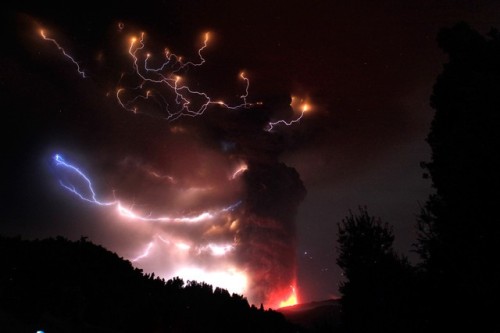

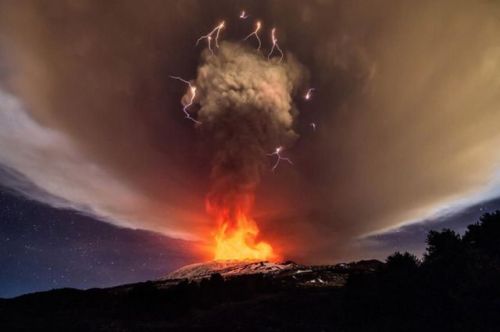
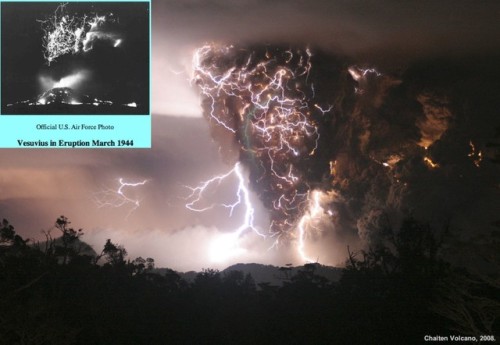

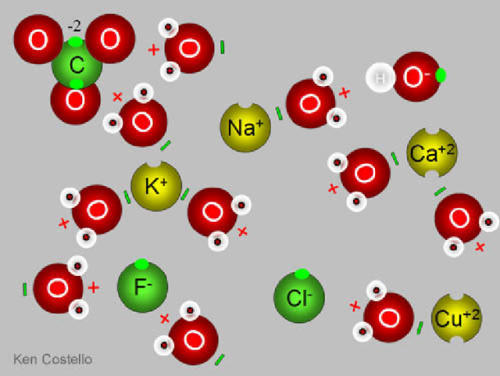

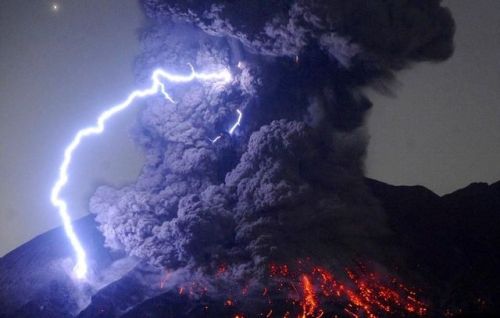
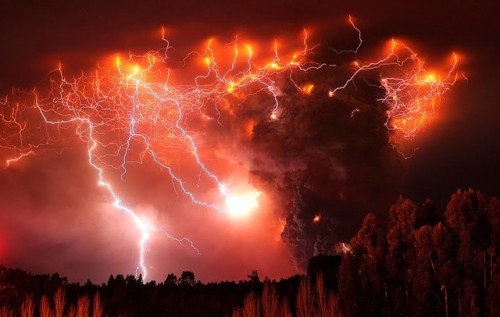
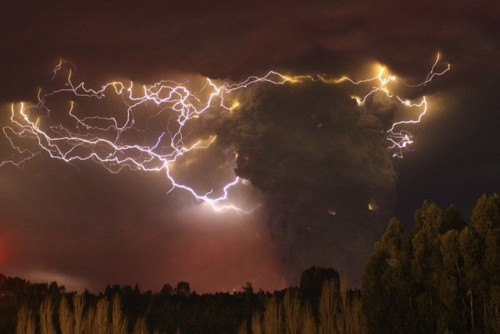
How Do Volcanoes Make Lightning?
“Volcanic lightning appears to occur most frequently around volcanoes with large ash plumes, particularly during active stages of the eruption, where flowing, molten lava creates the largest temperature gradients. The phenomena of lightning has been exquisitely recorded around a number of recent volcanic eruptions, including Iceland’s Eyjafjallajökull, Japan’s Sakurajima, Italy’s Mt. Etna, and Chile’s Puyehue, Calbuco and Chaiten volcanoes. But what you may not know is this phenomenon was not only captured during Mt. Vesuvius’ last eruption in 1944, but was accurately described nearly 2,000 years ago when it erupted all the way back in the year 79!”
Volcanoes are some of the most potentially destructive natural phenomena known to occur on our world. The most violent eruptions feature not only lava, but soot, ash, volatile gases, and even enormous chunks of rock hurled great distances. What you might not realize, however, is just how frequently these eruptions are accompanied by another spectacular show: volcanic lightning. Lightning isn’t only found in thunderstorms or other great electrical discharges between the clouds and the ground, but is produced in volcanic eruptions all throughout the world, and throughout history as well. After countless generations, where we wondered what could produce such an unusual but spectacular show, we’ve finally figured it out.
Come get the science behind how volcanoes make lightning, and enjoy some of the greatest photographs of this phenomena humanity’s ever taken!
Solar System: Things to Know This Week
There’s even more to Mars.

1. Batten Down the Hatches
Good news for future astronauts: scientists are closer to being able to predict when global dust storms will strike the Red Planet. The winds there don’t carry nearly the same force that was shown in the movie “The Martian,” but the dust lofted by storms can still wreak havoc on people and machines, as well as reduce available solar energy. Recent studies indicate a big storm may be brewing during the next few months.
+ Get the full forecast

2. Where No Rover Has Gone Before
Our Opportunity Mars rover will drive down an ancient gully that may have been carved by liquid water. Several spacecraft at Mars have observed such channels from a distance, but this will be the first up-close exploration. Opportunity will also, for the first time, enter the interior of Endeavour Crater, where it has worked for the last five years. All this is part of a two-year extended mission that began Oct. 1, the latest in a series of extensions going back to the end of Opportunity’s prime mission in April 2004. Opportunity landed on Mars in January of that year, on a mission planned to last 90 Martian days (92.4 Earth days). More than 12 Earth years later, it’s still rolling.
+ Follow along + See other recent pictures from Endeavour Crater

3. An Uphill Climb
Opportunity isn’t the only NASA Mars rover getting a mission extension. On the other side of the planet, the Curiosity rover is driving and collecting samples amid some of the most scenic landscapes ever visited on Mars. Curiosity’s two-year mission extension also began Oct. 1. It’s driving toward uphill destinations, including a ridge capped with material rich in the iron-oxide mineral hematite, about a mile-and-a-half (two-and-a-half kilometers) ahead. Beyond that, there’s an exposure of clay-rich bedrock. These are key exploration sites on lower Mount Sharp, which is a layered, Mount-Rainier-size mound where Curiosity is investigating evidence of ancient, water-rich environments that contrast with the harsh, dry conditions on the surface of Mars today.
+ Learn more

4. Keep a Sharp Lookout
Meanwhile, the Mars Reconnaissance Orbiter continues its watch on the Red Planet from above. The mission team has just released a massive new collection of super-high-resolution images of the Martian surface.
+ Take a look

5. 20/20 Vision for the 2020 Rover
In the year 2020, Opportunity and Curiosity will be joined by a new mobile laboratory on Mars. In the past week, we tested new “eyes” for that mission. The Mars 2020 rover’s Lander Vision System helped guide the rocket to a precise landing at a predesignated target. The system can direct the craft toward a safe landing at its primary target site or divert touchdown toward better terrain if there are hazards in the approaching target area.
+ Get details
Discover the full list of 10 things to know about our solar system this week HERE.
Make sure to follow us on Tumblr for your regular dose of space: http://nasa.tumblr.com
Solar System: Things to Know This Week
Mark your calendars for summer 2018: That’s when we’re launching a spacecraft to touch the sun.
In honor of our first-ever mission to the heart of the solar system, this week we’re delving into the life and times of this powerful yellow dwarf star.

1. Meet Parker
Parker Solar Probe, our first mission to go to the sun, is named after Eugene Parker, an American astrophysicist who first theorized that the sun constantly sends out a flow of particles and energy called the solar wind. This historic mission will explore one of the last regions of the solar system to be visited by a spacecraft and help scientists unlock answers to questions they’ve been pondering for more than five decades.

2. Extra SPF, Please
Parker Solar Probe will swoop within 4 million miles of the sun’s surface, facing heat and radiation like no spacecraft before it. The mission will provide new data on solar activity to help us better understand our home star and its activity - information that can improve forecasts of major space-weather events that could impact life on Earth.

3. Majorly Massive
The sun is the center of our solar system and makes up 99.8 percent of the mass of the entire solar system. If the sun were as tall as a typical front door, Earth would be about the size of a nickel.
4. Different Spin
Since the sun is not a solid body, different parts of the sun rotate at different rates. At the equator, the sun spins once about every 25 days, but at its poles the sun rotates once on its axis every 36 Earth days.

5. Can’t Stand on It
The sun is a star and a star doesn’t have a solid surface. Rather, it’s a ball of ionized gas 92.1% hydrogen (H2) and 7.8% helium (He) held together by its own gravity.
6. Center of Attention
The sun isn’t a planet, so it doesn’t have any moons. But, the sun is orbited by eight planets, at least five dwarf planets, tens of thousands of asteroids, and hundreds of thousands to trillions of comets and icy bodies.

7. It’s Hot in There
And we mean really, really hot. The temperature at the sun’s core is about 27 million degrees Fahrenheit. However, its atmosphere, the corona, can reach temperatures of 3 million degrees. (That’s as if it got hotter the farther away you got from a fire, instead of cooler!) Parker Solar Probe will help scientists solve the mystery of why the corona’s temperature is so much higher than the surface.

8. Travel Conditions
The sun influences the entire solar system, so studying it helps us better understand the space weather that our astronauts and spacecraft travel through.
9. Life on the Sun?
Better to admire from afar. Thanks to its hot, energetic mix of gases and plasma, the sun can’t be home to living things. However, we can thank the sun for making life on Earth possible by providing the warmth and energy that supply Earth’s food chain.
10. Chance of a Lifetime
Last but not least, don’t forget that the first total solar eclipse to sweep across the U.S. from coast-to-coast since 1918 is happening on August 21, 2017. Our toolkit has you need to know to about it.
Want to learn more? Read our full list of the 10 things to know this week about the solar system HERE.
Make sure to follow us on Tumblr for your regular dose of space: http://nasa.tumblr.com
Habe Mut, dich deines eigenen Verstandes zu bedienen.
Have the courage to use your own mind.
Immanuel Kant (1724 – 1804), German philosopher
(via jedentageinzitat)


The Van Allen Belt & the South Atlantic Anomaly
NASA’s first satellite, launched in 1958, discovered two giant swaths of radiation encircling Earth. Five decades later, scientists are still trying to unlock the mysteries of these phenomena known as the Van Allen belt. The belt is named after its discoverer, American astrophysicist James Van Allen.
The near-Earth space environment is a complex interaction between the planet’s magnetic field, cool plasma moving up from Earth’s ionosphere, and hotter plasma coming in from the solar wind. This dynamic region is populated by charged particles (electrons and ions) which occupy regions known as the plasmasphere and the Van Allen radiation belt. As solar wind and cosmic rays carry fast-moving, highly energized particles past Earth, some of these particles become trapped by the planet’s magnetic field. These particles carry a lot of energy, and it is important to mention their energies when describing the belt, because there are actually two distinct belts; one with energetic electrons forming the outer belt, and a combination of protons and electrons creating the inner belt. The resulting belts, can swell or shrink in size in response to incoming particles from Earth’s upper atmosphere and changes in the solar wind. Recent studies suggest that there is boundary at the inner edge of the outer belt at roughly 7,200 miles in altitude that appears to block the ultrafast electrons from breaching the invisible shield that protects Earth.
Earth’s magnetic field doesn’t exactly line up with the planet’s rotation axis, the belts are actually tilted a bit. Because of this asymmetry, one of the shields that trap potentially harmful particles from space dips down to 200 km (124 mi) altitude.

This dip in the earth’s magnetic field allows charged particles and cosmic rays to reach lower into the atmosphere. Satellites and other low orbiting spacecraft passing through this region of space actually enter the Van Allen radiation belt and are bombarded by protons. Exposure to such radiation can wreak havoc on satellite electronics, and pose serious health risks to astronauts. This peculiar region is called the South Atlantic Anomaly.
Credit: NASA/ESA/M. Kornmesser
-
 dimens1ons liked this · 8 years ago
dimens1ons liked this · 8 years ago -
 kinkylube liked this · 10 years ago
kinkylube liked this · 10 years ago -
 aninterestingturnofevents liked this · 10 years ago
aninterestingturnofevents liked this · 10 years ago -
 whatnowbiatch reblogged this · 10 years ago
whatnowbiatch reblogged this · 10 years ago -
 ijuanasmoke reblogged this · 10 years ago
ijuanasmoke reblogged this · 10 years ago -
 quantum-mecha reblogged this · 10 years ago
quantum-mecha reblogged this · 10 years ago -
 theknaffrican-blog reblogged this · 10 years ago
theknaffrican-blog reblogged this · 10 years ago -
 le-coeur-dor liked this · 10 years ago
le-coeur-dor liked this · 10 years ago -
 le-coeur-dor reblogged this · 10 years ago
le-coeur-dor reblogged this · 10 years ago -
 thegrizzman reblogged this · 10 years ago
thegrizzman reblogged this · 10 years ago -
 melixxj liked this · 10 years ago
melixxj liked this · 10 years ago -
 anayasmith-hunter liked this · 10 years ago
anayasmith-hunter liked this · 10 years ago -
 dudeemmaskates reblogged this · 10 years ago
dudeemmaskates reblogged this · 10 years ago -
 dudeemmaskates liked this · 10 years ago
dudeemmaskates liked this · 10 years ago -
 thatonephatpanda liked this · 10 years ago
thatonephatpanda liked this · 10 years ago -
 9-milli reblogged this · 10 years ago
9-milli reblogged this · 10 years ago -
 chaosisthemethod2themadness reblogged this · 10 years ago
chaosisthemethod2themadness reblogged this · 10 years ago -
 lachaesis713 reblogged this · 10 years ago
lachaesis713 reblogged this · 10 years ago -
 lachaesis713 liked this · 10 years ago
lachaesis713 liked this · 10 years ago -
 mister-dungus reblogged this · 10 years ago
mister-dungus reblogged this · 10 years ago -
 mister-dungus liked this · 10 years ago
mister-dungus liked this · 10 years ago -
 bedroots reblogged this · 10 years ago
bedroots reblogged this · 10 years ago -
 preachingtoinfinity reblogged this · 10 years ago
preachingtoinfinity reblogged this · 10 years ago -
 topazwoods liked this · 10 years ago
topazwoods liked this · 10 years ago -
 misguidedagression reblogged this · 10 years ago
misguidedagression reblogged this · 10 years ago -
 messier82-blog liked this · 10 years ago
messier82-blog liked this · 10 years ago -
 justactg liked this · 10 years ago
justactg liked this · 10 years ago -
 harveythelion liked this · 10 years ago
harveythelion liked this · 10 years ago -
 star-atelier reblogged this · 10 years ago
star-atelier reblogged this · 10 years ago -
 capitandequeso reblogged this · 10 years ago
capitandequeso reblogged this · 10 years ago -
 capitandequeso liked this · 10 years ago
capitandequeso liked this · 10 years ago -
 aluminothermic liked this · 10 years ago
aluminothermic liked this · 10 years ago -
 aluminothermic reblogged this · 10 years ago
aluminothermic reblogged this · 10 years ago -
 quantum-mecha liked this · 10 years ago
quantum-mecha liked this · 10 years ago -
 venearla liked this · 10 years ago
venearla liked this · 10 years ago -
 mean-mom reblogged this · 10 years ago
mean-mom reblogged this · 10 years ago -
 galactic-humans liked this · 10 years ago
galactic-humans liked this · 10 years ago -
 hildegardvonbingenthethird reblogged this · 10 years ago
hildegardvonbingenthethird reblogged this · 10 years ago -
 spacetime-trainwreck-blog liked this · 10 years ago
spacetime-trainwreck-blog liked this · 10 years ago -
 thewilliamambervein reblogged this · 10 years ago
thewilliamambervein reblogged this · 10 years ago
